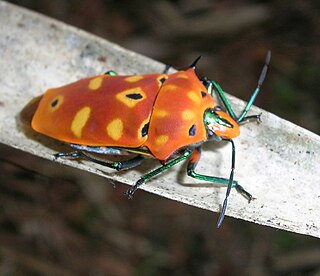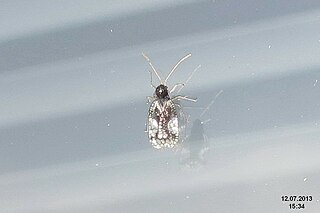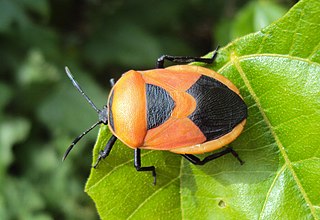
The Pentatomoidea are a superfamily of insects in the Heteroptera suborder of the Hemiptera order. As Hemiptera, they share a common arrangement of sucking mouthparts. The roughly 7000 species under Pentatomoidea are divided into 21 families. Among these are the shield bugs, giant shield bugs, burrower bugs, and stink bugs.

Pyrrhocoridae is a family of insects with more than 300 species world-wide. Many are red coloured and are known as red bugs and some species are called cotton stainers because their feeding activities leave an indelible yellow-brownish stain on cotton crops. A common species in parts of Europe is the firebug, and its genus name Pyrrhocoris and the family name are derived from the Greek roots for fire "pyrrho-" and bug "coris". Members of this family are often confused with, but can be quickly separated from, Lygaeidae by the lack of ocelli on the top of the head.

Nepidae is a family of exclusively aquatic Heteropteran insects in the order Hemiptera. They are commonly called water scorpions for their superficial resemblance to scorpions, due to their raptorial forelegs and the presence of a long slender process at the posterior end of the abdomen, resembling a tail. There are 14 genera in the family, in two subfamilies, Nepinae and Ranatrinae. Members of the genus Ranatra, the most widespread and species-rich genus, are sometimes called needle bugs or water stick insects as they are slenderer than Nepa.

Ranatra is a genus of slender predatory insects of the family Nepidae, known as water scorpions or water stick-insects. There are around 100 Ranatra species found in freshwater habitats around the world, both in warm and temperate regions, with the highest diversity in South America and Asia. Fewer are found elsewhere, but include several African, some in North America, three from Australia and three from the Palearctic, notably the relatively well-known European R. linearis.

The Harpactorinae are a large subfamily of the Reduviidae. About 300 genera and 2,000 species worldwide have been described. Some of the species of the genera Zelus, Pselliopus, Sinea, and Apiomerus are of interest as biological pest control agents.

Cantao is a genus of true bugs in family Scutelleridae.

Tessaratomidae is a family of true bugs. It contains about 240 species of large bugs divided into 3 subfamilies and 56 genera.

The Dinidoridae are a small family of insects comprising about a hundred species in sixteen genera in the Hemipteran suborder Heteroptera, the "true bugs". As a group the family does not have any common name. Until the late 19th century they were generally regarded as a subfamily of the Pentatomidae.

The Blissidae are a family in the Hemiptera, comprising nearly 50 genera and 400 species. The group has often been treated as a subfamily of the Lygaeidae but was resurrected as a full family by Thomas Henry (1997).
Ammianus is a genus of lace bugs in the family Tingidae. There are at least 40 described species in Ammianus.
Belenus is a genus of lace bugs in the family Tingidae. There are about nine described species in Belenus.
Eteoneus is a genus of lace bugs in the family Tingidae. There are at least 20 described species in Eteoneus.
Haedus is a genus of lace bugs in the family Tingidae. There are at least 30 described species in Haedus.
Lullius is a genus of lace bugs in the family Tingidae. There are about eight described species in Lullius.

Stephanitis is a genus of lace bugs in the family Tingidae. There are at least 90 described species in Stephanitis.
Cantacaderinae is a subfamily of lace bugs in the family Tingidae. There are about 16 genera and at least 90 described species in Cantacaderinae.

Cyclopelta siccifolia is a bug in the family Dinidoridae found in South Asia. It is known for its large aggregations on certain species of plants. They have been known to aggregate and damage Erythrina, Sesbania, Pongamia, and Cajanus cajan.

Physopelta is a genus of bordered plant bugs in the family Largidae. There are about 30 described species in Physopelta, found in Asia and Oceania.

Coridius is a genus of dinidorid bugs. They suck sap mainly from plants belonging to the family Cucurbitaceae. About forty species are known with a native distribution mainly in Africa and Asia. Several species are eaten in parts of South and Southeast Asia. Some species have extended into Europe and are considered as pests on cucurbit crops.

Gynenica is a genus of stink bug with about fourteen species in the Afrotropical and Oriental regions. It is one of four genera placed in the tribe Lestonocorini along with Lestonocoris, Neogynenica, and Umgababa that occur in Africa and India and feed on plants in the family Acanthaceae. Bugs in the genus have the pronotum tips extended into forward and upward curving spines. The scutellum is longer than broad, the apex with a rounded point and not reaching beyond the middle of the abdomen.














